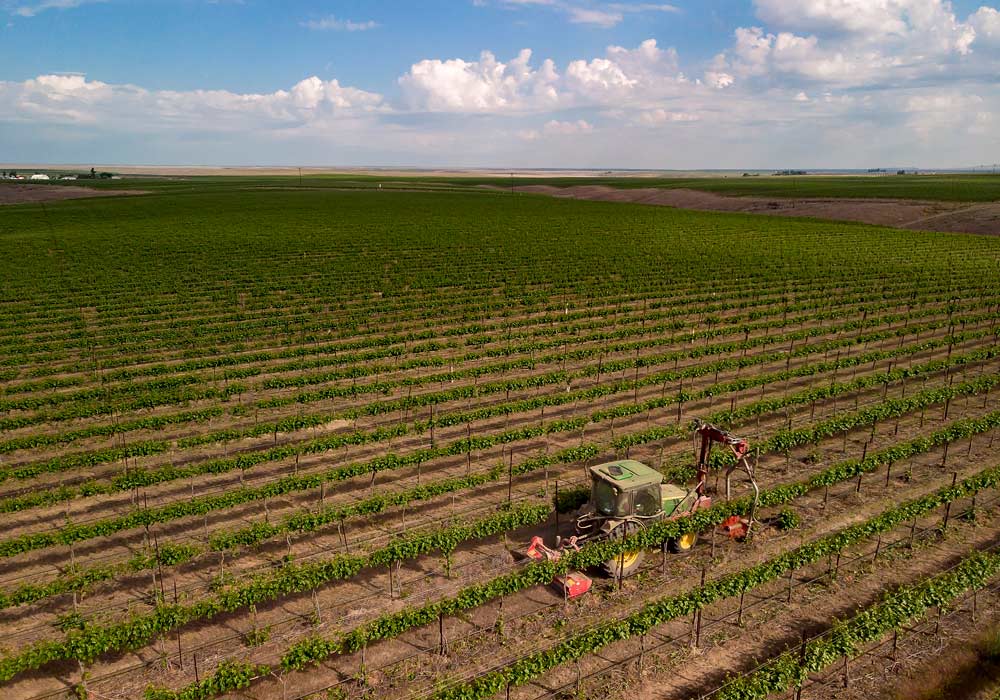
Sucker and shoot thinning, seen here in a Cabernet Sauvignon block in May, is entirely mechanized at Mercer Ranches near Alderdale, Washington. Richard Hoff, director of viticulture, says the company’s six thinning machines can cover between 50 and 60 acres a day, though that depends on driver experience and other factors. Hoff estimates they have about a three-week window to easily and efficiently clear shoots and suckers with the machine. (TJ Mullinax/Good Fruit Grower)
The vineyards of Mercer Ranches never sleep.
Precision pruners mounted to over-the-row harvesters run row after row, 24 hours a day, to get the vineyard’s 3,400 acres pruned before bud break each spring in Washington’s Horse Heaven Hills.
That pruning — with sharp blades grinding away just a few inches above the cordon — is the backbone of a mechanized program many years in the making, said Richard Hoff, the company’s director of viticulture.
With the exception of very young blocks and a few premium blocks contracted to winemakers who want hand labor, the entire vineyard is managed by machines that prune, de-sucker, shoot thin, cut crop load, pull leaves and harvest.
“I love mechanization. It’s fun because you have to think outside the box,” Hoff told Good Fruit Grower in the first of a series of interviews about how Mercer Ranches has learned to almost completely mechanize its vineyard operations because skilled labor is so hard to find in the remote region where the vineyards are located. “But we’re not doing this because it’s a genius way to save money. It’s a very intense program.”
It was stressful at first, a few years ago, to let these “crude machines” run through a high-end block that needed to be cut back to just 2.5 tons per acre, Hoff said. But the resulting fruit quality has since put those fears to rest.
“That’s the cool thing about mechanizing in Washington. Most places in the world are mechanizing stuff that’s going to be $2 a bottle, while we’re mechanizing premium wine,” Hoff said at a panel on mechanization at the Washington Winegrowers Association annual convention in February.
Winemaker wariness of mechanization is fading, said Ray McKee, winemaker for Canoe Ridge Vineyards, at the same panel.
“I was highly skeptical of mechanization, but then I wholeheartedly jumped in,” McKee said. He discussed wines made from Mercer’s vineyards and wines made after trials by Ste. Michelle Wine Estates that compared conventional and mechanical grapes. “As far as individual batches of wine go, they are almost identical. It is just a tool and if you learn how to use it properly, through trial and error, I think in the long run, it’s beneficial.”
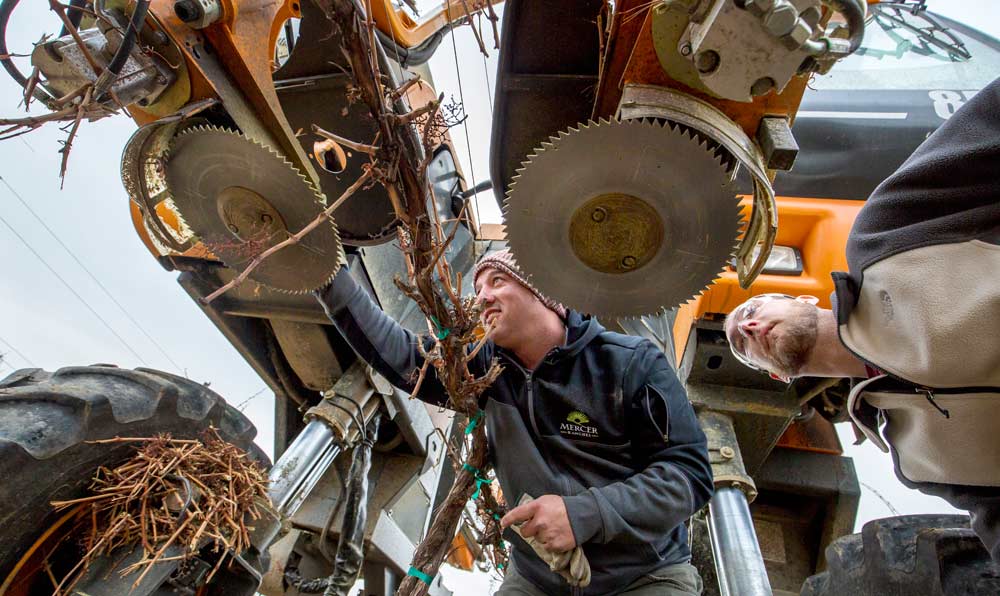
Camerino Gutierrez, left, and Richard Hoff, director of viticulture at Mercer Ranches, service a mechanical pruner in one of their wine grape blocks. Sharp blades are a must to ensure quality from the precision pruner. (TJ Mullinax/Good Fruit Grower)
A fully mechanized vineyard
This was the fourth winter that Pellanc’s TRP Precision Pruners have chewed through Mercer’s vineyards, mounted on the company’s over-the-row harvesters. Hoff said when he was hired, the vineyard owner directed him to pursue mechanization as much as possible, and this tool provided the best place to start.
“The first year of doing this was super stressful,” he said about the precision pruner, which, despite its name, is still a crude tool of sharp blades running just above the cordons. Good training of a VSP (vertical shoot position) system and level cordons help. “I was really happy with the results in year one, but we’re still learning. Every year we can do better.”
Equipped with cameras that keep watch for the cordon and trellis posts, the pruner automatically adjusts the blade height to the cordon on a regular, but not continuous basis. Hoff sets the pruner’s aggressiveness based on bud counts and the desired crop load for each block.
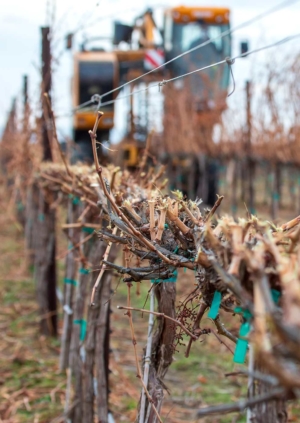
Running the Pellanc TRP precision pruner on an over-the-row harvester allows for the most stable, consistent cut, Hoff says. Here, the pruner works in a Cabernet Sauvignon block in January. (TJ Mullinax/Good Fruit Grower)
The pruner can also run on a vineyard tractor, but Hoff prefers to use the more expensive-to-operate harvester because it provides more stability and level performance. Operators sit well above the vines, however, so it takes time to learn to run the equipment well.
The pruner automatically opens its blades to go around posts accurately most of the time, leaving the shoots around the post for a hand crew to follow up. The crew can move through at a “walking pace,” Hoff said, cleaning up the posts and a few misses here and there.
The shorn look that results is different than if a hand crew had selectively pruned for prime positioning, and “everything you’ve learned about pruning is out the window,” he said, but it still sets the structure for high-quality fruit.
The next machine to run the rows is a sucker remover and shoot thinner built by Prosser, Washington-based supplier Vine Tech. Mounted to a tractor, the machine features two spinning heads of spaghetti whips that whack off suckers and shoots on either side of the row. Hoff couples it with a mower to make the most of each pass with the tractor.
In young blocks that don’t have good structure, the shoot thinning can easily do some damage, but once the cordon is well established and “one with the wire,” it runs well, Hoff said.
Timing is key because young shoots and suckers are easier to strip off, but the machine is available with different heads and whips of different materials to adapt to the needs of different vineyards, said Grant De Vries, sales manager for Vine Tech.
“We try to find a happy medium between eliminating as much crop as possible and leaving good pruning positions for next year,” Hoff said.
This season, he also tested out a double row shoot thinner made by Fresno, California-based V-Mech. The thinning and suckering work is done with a similar head of rotating whips, but it requires two operators — one for each row — to ride behind the tractor and direct the thinning.
So, it’s half as many passes for the tractor, but operating it takes three people, or one and a half per row, Hoff said.
The benefit is that the operators are more focused on thinning since they don’t also have to drive, but he’s not sure yet if the gains in speed or performance are worth it.
Then, in the early summer, Hoff aims to run a leafer through the vineyards. He starts leaf pulling a few weeks earlier than most growers do — when the berries are pea sized — so that the leaf removing suction also reduces his crop load. Later on, the larger clusters are not susceptible to the leaf-removing suction, which is designed to protect them.
“I’m trying to do it early, so I have a tight window. We’ve got seven leafers going full time, 24 hours a day, so I have to get the wires up ASAP,” he said.
And that is the final challenge Mercer has yet to mechanize: lifting the canopy. In June, Hoff hired a contract crew for a few weeks to get the canopy up and ready for leafing. “The problem with farming is not that you need labor, but that you need a lot of people immediately, all at once,” Hoff said.
He’s tested out two canopy and wire lifting machines without finding one that works well in his vineyards. The Pellanc model uses plastic clips to hold the lifted wires in place, but wire tension and canopy size variation can create problems. It’s the last piece of the mechanization puzzle they need, Hoff said.
De Vries said he’s working with another vineyard using a canopy lifter, made by Italian manufacturer Volentieri, that essentially replaces the wire with twine that is rolled out as the canopy is raised to hold it in place, so it doesn’t struggle with variable wire tension the way other alternative systems do.
But Hoff is hesitant about the twine, which would need to be taken down every year before it gets tangled in the pruners. Plus, Mercer’s vineyards already have existing steel wires, so they would rather not buy twine every year.
But once the wires are up, the leaves are pulled and the crop load adjusted, the last phase of mechanized management is harvest, which has rapidly become the norm in most of Washington’s commercial vineyards.
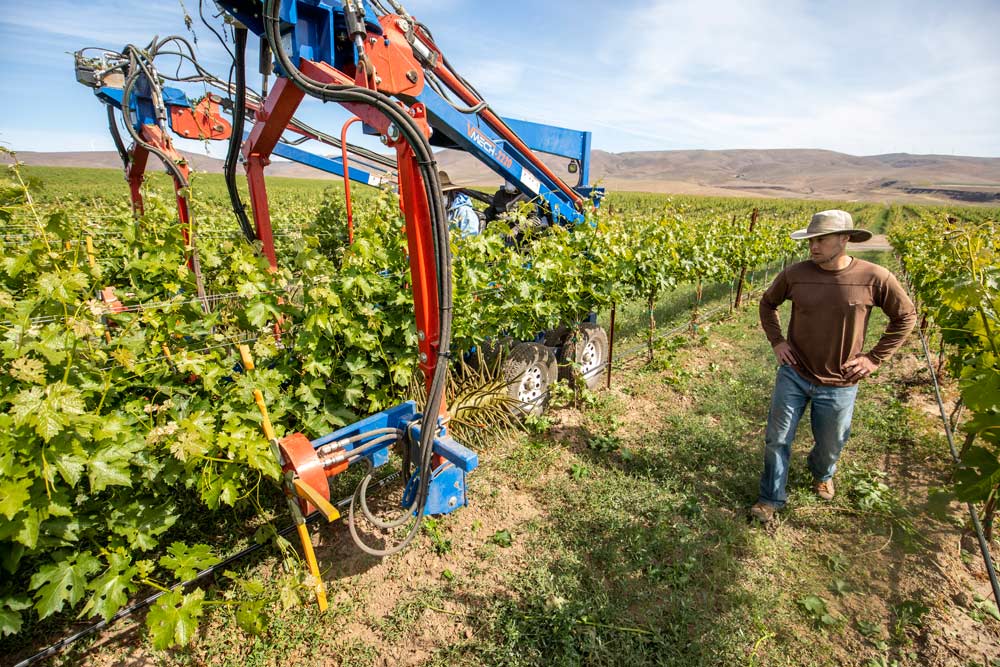
Hoff evaluates the performance of a double-row shoot and sucker thinning machine, which requires a tractor driver and two operators, in a Cabernet Sauvignon block in May. This machine allows operators to focus on thinning without also having to drive and cuts tractor passes in half, but increases the workers needed per row. (TJ Mullinax/Good Fruit Grower)
More growers take the plunge
With four years of fine-tuning this system under his belt, Hoff is often invited to panels and conferences to share his experience. But he insists that this is the sort of thing people need to learn by doing it themselves in their own vineyard.
“The reality is you guys have different vineyards, your trellises are different, your vines are different ages, your goals are different,” he said at the winegrowers’ convention. “You’ll just learn as you go. It’s not rocket science. You just have to start playing with it.”
That said, Hoff did offer some advice: figure out how to control the things you can control.
“You can’t control the fact that your TRP is only looking for the cordon every 9 inches, and you can’t control that your shoot thinner is running on uneven ground,” he said. “But I can make sure the blades are sharp, I can make sure the machine is level. The minutia is like compound interest. You have to do those minor things very well for your tools to work well.”
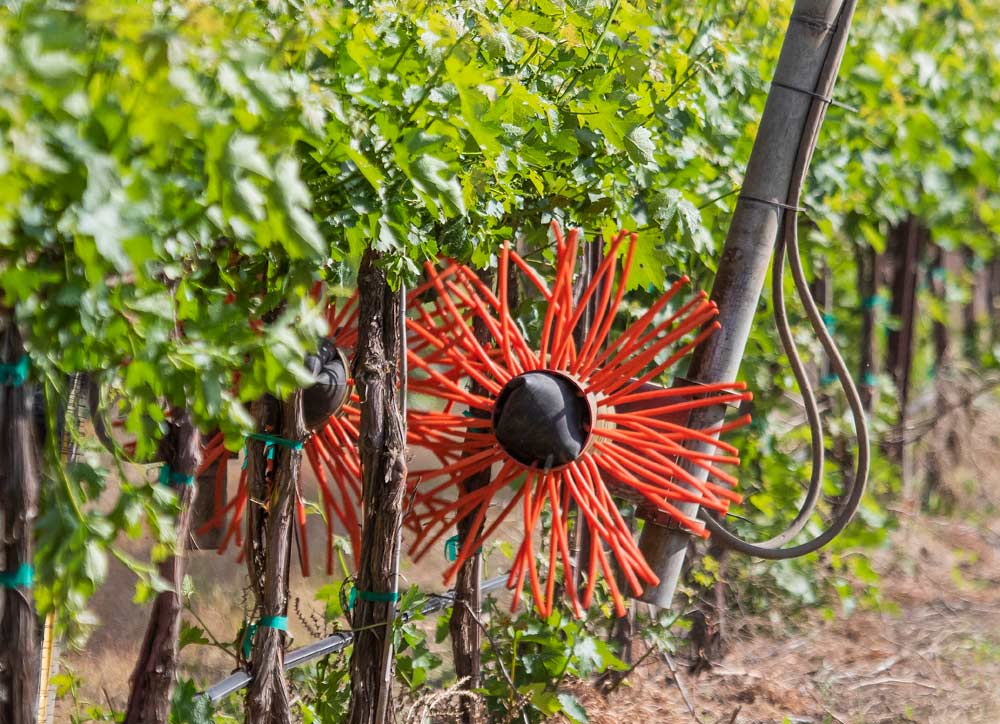
Whirling rubber whips strip shoots and suckers from the vines. (TJ Mullinax/Good Fruit Grower)
Figuring out how to make the tools work for your vineyard — considering factors such as placement of drip lines and how that may interfere with use of the sucker and shoot remover, for example — can be complicated. But at least for that equipment, Vine Tech offers a variety of adaptations to help growers find the right fit, De Vries said.
Designing a vineyard from the outset for this kind of management is easier than adapting existing acreage, Hoff said, although that’s the more common way for growers to start experimenting.
“It becomes harder to retrofit a vineyard to mechanize it the longer you wait,” said Joe Cotta, manager of Ste. Michelle Wine Estates’ Cold Creek Vineyard.
At the convention, he shared some insights from his first forays with the precision pruner and shoot thinner in their vineyards, including accidentally ripping out some vines when the shoot thinner was moving too aggressively.
“You may wreck stuff in the process, but you learn a lot,” Cotta said.
The first step for growers looking to get into mechanized management is usually the leaf puller, De Vries said.
“At 50 to 60 acres, you can justify a leaf puller,” he said. “Your second tool would probably be a pre-pruner or precision pruner. And then the sucker and shoot thinner. I’m assuming they are already doing mechanical harvest.”
Over the past few years, De Vries has had about 15 customers in the Northwest running the precision pruner, sucker remover or both, and as the labor crunch continues, he expects interest to grow.
Hoff said that investing in mechanization and learning how to optimize this new method of management has been more costly than most people think, but it has now put Mercer in a good position to weather the labor challenges the industry faces. •
—by Kate Prengaman






Leave A Comment